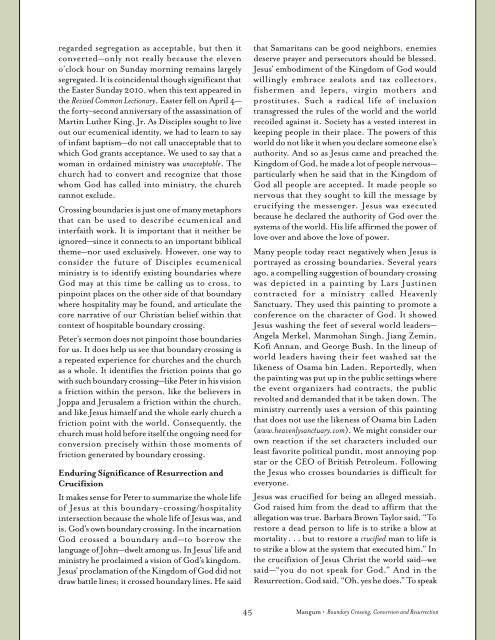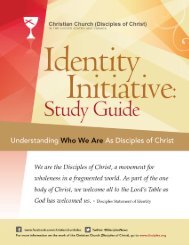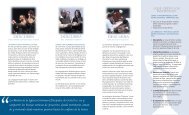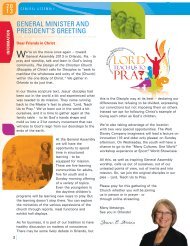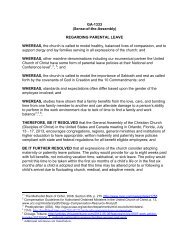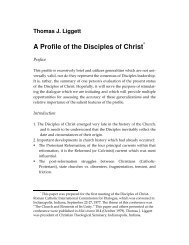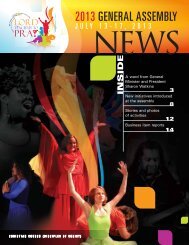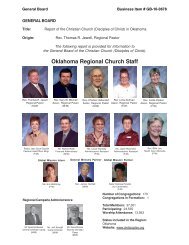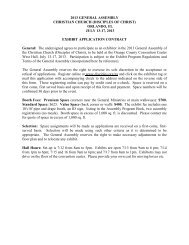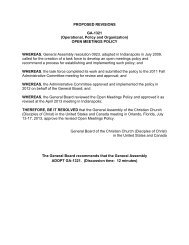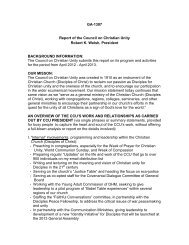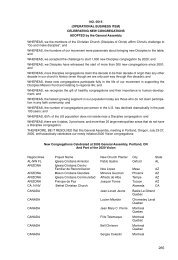RESOURCING THE CHURCH FOR ECUMENICAL MINISTRy A ...
RESOURCING THE CHURCH FOR ECUMENICAL MINISTRy A ...
RESOURCING THE CHURCH FOR ECUMENICAL MINISTRy A ...
You also want an ePaper? Increase the reach of your titles
YUMPU automatically turns print PDFs into web optimized ePapers that Google loves.
egarded segregation as acceptable, but then it<br />
converted—only not really because the eleven<br />
o’clock hour on Sunday morning remains largely<br />
segregated. It is coincidental though significant that<br />
the Easter Sunday 2010, when this text appeared in<br />
the Revised Common Lectionary, Easter fell on April 4—<br />
the forty-second anniversary of the assassination of<br />
Martin Luther King, Jr. As Disciples sought to live<br />
out our ecumenical identity, we had to learn to say<br />
of infant baptism—do not call unacceptable that to<br />
which God grants acceptance. We used to say that a<br />
woman in ordained ministry was unacceptable. The<br />
church had to convert and recognize that those<br />
whom God has called into ministry, the church<br />
cannot exclude.<br />
Crossing boundaries is just one of many metaphors<br />
that can be used to describe ecumenical and<br />
interfaith work. It is important that it neither be<br />
ignored—since it connects to an important biblical<br />
theme—nor used exclusively. However, one way to<br />
consider the future of Disciples ecumenical<br />
ministry is to identify existing boundaries where<br />
God may at this time be calling us to cross, to<br />
pinpoint places on the other side of that boundary<br />
where hospitality may be found, and articulate the<br />
core narrative of our Christian belief within that<br />
context of hospitable boundary crossing.<br />
Peter’s sermon does not pinpoint those boundaries<br />
for us. It does help us see that boundary crossing is<br />
a repeated experience for churches and the church<br />
as a whole. It identifies the friction points that go<br />
with such boundary crossing—like Peter in his vision<br />
a friction within the person, like the believers in<br />
Joppa and Jerusalem a friction within the church,<br />
and like Jesus himself and the whole early church a<br />
friction point with the world. Consequently, the<br />
church must hold before itself the ongoing need for<br />
conversion precisely within those moments of<br />
friction generated by boundary crossing.<br />
Enduring Significance of Resurrection and<br />
Crucifixion<br />
It makes sense for Peter to summarize the whole life<br />
of Jesus at this boundary-crossing/hospitality<br />
intersection because the whole life of Jesus was, and<br />
is, God’s own boundary crossing. In the incarnation<br />
God crossed a boundary and—to borrow the<br />
language of John—dwelt among us. In Jesus’ life and<br />
ministry he proclaimed a vision of God’s kingdom.<br />
Jesus’ proclamation of the Kingdom of God did not<br />
draw battle lines; it crossed boundary lines. He said<br />
45<br />
that Samaritans can be good neighbors, enemies<br />
deserve prayer and persecutors should be blessed.<br />
Jesus’ embodiment of the Kingdom of God would<br />
willingly embrace zealots and tax collectors,<br />
fishermen and lepers, virgin mothers and<br />
prostitutes. Such a radical life of inclusion<br />
transgressed the rules of the world and the world<br />
recoiled against it. Society has a vested interest in<br />
keeping people in their place. The powers of this<br />
world do not like it when you declare someone else’s<br />
authority. And so as Jesus came and preached the<br />
Kingdom of God, he made a lot of people nervous—<br />
particularly when he said that in the Kingdom of<br />
God all people are accepted. It made people so<br />
nervous that they sought to kill the message by<br />
crucifying the messenger. Jesus was executed<br />
because he declared the authority of God over the<br />
systems of the world. His life affirmed the power of<br />
love over and above the love of power.<br />
Many people today react negatively when Jesus is<br />
portrayed as crossing boundaries. Several years<br />
ago, a compelling suggestion of boundary crossing<br />
was depicted in a painting by Lars Justinen<br />
contracted for a ministry called Heavenly<br />
Sanctuary. They used this painting to promote a<br />
conference on the character of God. It showed<br />
Jesus washing the feet of several world leaders—<br />
Angela Merkel, Manmohan Singh, Jiang Zemin,<br />
Kofi Annan, and George Bush. In the lineup of<br />
world leaders having their feet washed sat the<br />
likeness of Osama bin Laden. Reportedly, when<br />
the painting was put up in the public settings where<br />
the event organizers had contracts, the public<br />
revolted and demanded that it be taken down. The<br />
ministry currently uses a version of this painting<br />
that does not use the likeness of Osama bin Laden<br />
(www.heavenlysanctuary.com). We might consider our<br />
own reaction if the set characters included our<br />
least favorite political pundit, most annoying pop<br />
star or the CEO of British Petroleum. Following<br />
the Jesus who crosses boundaries is difficult for<br />
everyone.<br />
Jesus was crucified for being an alleged messiah.<br />
God raised him from the dead to affirm that the<br />
allegation was true. Barbara Brown Taylor said, “To<br />
restore a dead person to life is to strike a blow at<br />
mortality . . . but to restore a crucified man to life is<br />
to strike a blow at the system that executed him.” In<br />
the crucifixion of Jesus Christ the world said—we<br />
said—“you do not speak for God.” And in the<br />
Resurrection, God said, “Oh, yes he does.” To speak<br />
Mangum • Boundary Crossing, Conversion and Resurrection


